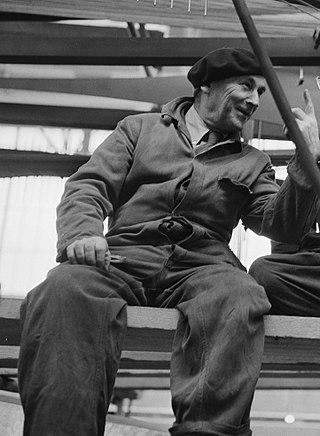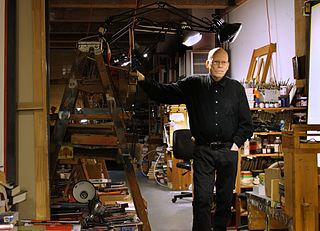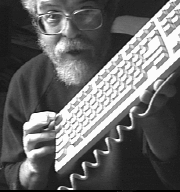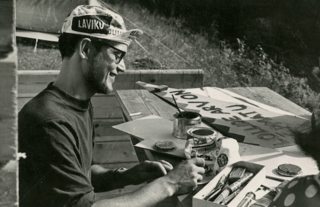Anya Gallaccio is a British artist, who creates site-specific, minimalist installations and often works with organic matter.

Leonard Charles Huia Lye was a New Zealand artist known primarily for his experimental films and kinetic sculpture. His films are held in archives including the New Zealand Film Archive, British Film Institute, Museum of Modern Art in New York City, and the Pacific Film Archive at University of California, Berkeley. Lye's sculptures are found in the collections of the Whitney Museum of American Art, the Art Institute of Chicago, the Albright-Knox Art Gallery and the Berkeley Art Museum. Although he became a naturalized citizen of the United States in 1950, much of his work went to New Zealand after his death, where it is housed at the Govett-Brewster Art Gallery in New Plymouth. He is best remembered for his 1933 short film "experimental Animation 1933," better known as "The Peanut Vendor."

Naum Gabo, born Naum Neemia Pevsner was an influential sculptor, theorist, and key figure in Russia's post-Revolution avant-garde and the subsequent development of twentieth-century sculpture. His work combined geometric abstraction with a dynamic organization of form in small reliefs and constructions, monumental public sculpture and pioneering kinetic works that assimilated new materials such as nylon, wire, lucite and semi-transparent materials, glass and metal. Responding to the scientific and political revolutions of his age, Gabo led an eventful and peripatetic life, moving to Berlin, Paris, Oslo, Moscow, London, and finally the United States, and within the circles of the major avant-garde movements of the day, including Cubism, Futurism, Constructivism, the Bauhaus, de Stijl and the Abstraction-Création group. Two preoccupations, unique to Gabo, were his interest in representing negative space—"released from any closed volume" or mass—and time. He famously explored the former idea in his Linear Construction works (1942-1971)—used nylon filament to create voids or interior spaces as "concrete" as the elements of solid mass—and the latter in his pioneering work, Kinetic Sculpture (1920), often considered the first kinetic work of art.

Panayiotis Vassilakis, also known as Takis, was a self-taught Greek artist known for his kinetic sculptures. He exhibited his artworks in Europe and the United States. Popular in France, his works can be found in public locations in and around Paris, as well as at the Athens-based Takis Foundation Research Center for the Arts and Sciences.

Frederick Rowland Emett OBE, known as Rowland Emett, was an English cartoonist and constructor of whimsical kinetic sculpture.
Lee Friedlander is an American photographer and artist. In the 1960s and 1970s, Friedlander evolved an influential and often imitated visual language of urban "social landscape," with many of his photographs including fragments of store-front reflections, structures framed by fences, posters and street signs. His work is characterized by its innovative use of framing and reflection, often using the natural environment or architectural elements to frame his subjects. Over the course of his career, Friedlander has been the recipient of numerous awards and his work has been exhibited in major museums and galleries worldwide.

Paul Laffoley was an American visionary artist and architect from Boston, Massachusetts.
Paul Jenkins was an American abstract expressionist painter.

Joseph Stanislaus Ostoja-Kotkowski AM, FRSA was best known for his ground-breaking work in chromasonics, laser kinetics and 'sound and image' productions. He earned recognition in Australia and overseas for his pioneering work in laser sound and image technology. His work included painting, photography, film-making, theatre design, fabric design, murals, kinetic and static sculpture, stained glass, vitreous enamel murals, op-collages, computer graphics, and laser art. Ostoja flourished between 1940 and 1994.
Sokari Douglas Camp CBE is a London-based artist who has had exhibitions all over the world and was the recipient of a bursary from the Henry Moore Foundation. She was honoured as a Commander of the Order of the British Empire (CBE) in the 2005 Birthday Honours list.
Ushio Shinohara, nicknamed “Gyū-chan”, is a Japanese contemporary painter, sculptor, and performance artist based in New York City. Best known for his vigorously painted, large-scale and dynamic Boxing Painting series, Shinohara makes use of embodied gestures, appropriation and assemblage, iconographies of mass culture and traditional arts, and vivid tones in his diverse, multidisciplinary practice.
Eusebio Sempere Juan was a Spanish sculptor, painter, and graphic artist whose abstract geometric works make him the most representative artist of the Kinetic art movement in Spain and one of Spain's foremost artists. His use of repetition of line and mastery of color to manipulate the way light plays on the surface give depth to his pictorial compositions.
Sachiko Kodama is a Japanese artist. She is best known for her artwork using ferrofluid, a dark colloidal suspension of magnetic nano-particles dispersed in solution which remains strongly magnetic in its fluid. By controlling the fluid with a magnetic field, it is formed to create complex 3-dimensional shapes as a "liquid sculpture".

Modern sculpture is generally considered to have begun with the work of Auguste Rodin, who is seen as the progenitor of modern sculpture. While Rodin did not set out to rebel against the past, he created a new way of building his works. He "dissolved the hard outline of contemporary Neo-Greek academicism, and thereby created a vital synthesis of opacity and transparency, volume and void". Along with a few other artists in the late 19th century who experimented with new artistic visions in sculpture like Edgar Degas and Paul Gauguin, Rodin invented a radical new approach in the creation of sculpture. Modern sculpture, along with all modern art, "arose as part of Western society's attempt to come to terms with the urban, industrial and secular society that emerged during the nineteenth century".

Lola Vyacheslavovna Lonli is a Russian painter working in the style of Russian cosmism. She is a member of the Artists Trade Union of Russia and The International Federation of Artists. Her works are in permanent collections of the International Centre of Roerichs (Moscow), The V. V. Vereshchagin Mykolaiv Art Museum, Simferopol Art Museum, and the art museum of Gorlovka. In 2013, her paintings were included in the catalogue Russian cosmists of the 20th and 21st centuries published by International Centre of Roerichs. Lonli's paintings are extensively exhibited throughout Russia and Ukraine; she has had more than fifty solo exhibitions and has participated in more than one hundred group exhibitions. She created her own method of art education and established the Treasure of the World art school.

United Visual Artists (UVA) is a London-based art practice founded in 2003 by British artist Matt Clark (b.1974). UVA's diverse body of work integrates new technologies with traditional media such as painting, sculpture, performance, and site-specific installation. The practice has an open and inclusive approach to collaboration. While Clark leads the UVA team, the plural use of the word "Artist" in its designation refers to the many collaborators with whom Clark works.

Dmitry Kawarga born in Moscow, Russia is a Russian artist. Kawarga began working in his own style of "biomorphism" striving to create a synthesis of science, art and technology. His art is featured in numerous museums and is part of the permanent collection of Erarta, Russia's largest private museum of contemporary art located in Saint Petersburg.

Jim Pallas is an American sculptor known for his electro-kinetic sculptures. “Zany, surrealistic, and ingenious in their construction, Mr. Pallas' work ushers us into the gaudy baroque phrase of kinetic art, as emanations of Paul Klee's Twittering Machines come back to haunt us in the language of our bizarre technology.” Pallas is one of the pioneers in electronic art. Detroit Art Critic, Joy Colby once described Pallas as having the “tinkering genius of Henry Ford combined with the ironic wit of Marcel Duchamp.”
Robert Owen is an Australian artist and curator. He lives and works in Melbourne, Australia.

Kaarel Kurismaa is the first and one of the most important sound art and sound installation artists in Estonia. His work also expands into the field of painting, animation, public space monumental art, stage installations. In Estonian art history, Kurismaa’s significance lies mostly in the pioneering work with kinetic art and with keeping its traditions alive. Kurismaa stands as one of Estonian sound art scene’s central icons. His idiosyncratic work serves as a foundation for Estonian sound and kinetic art.















